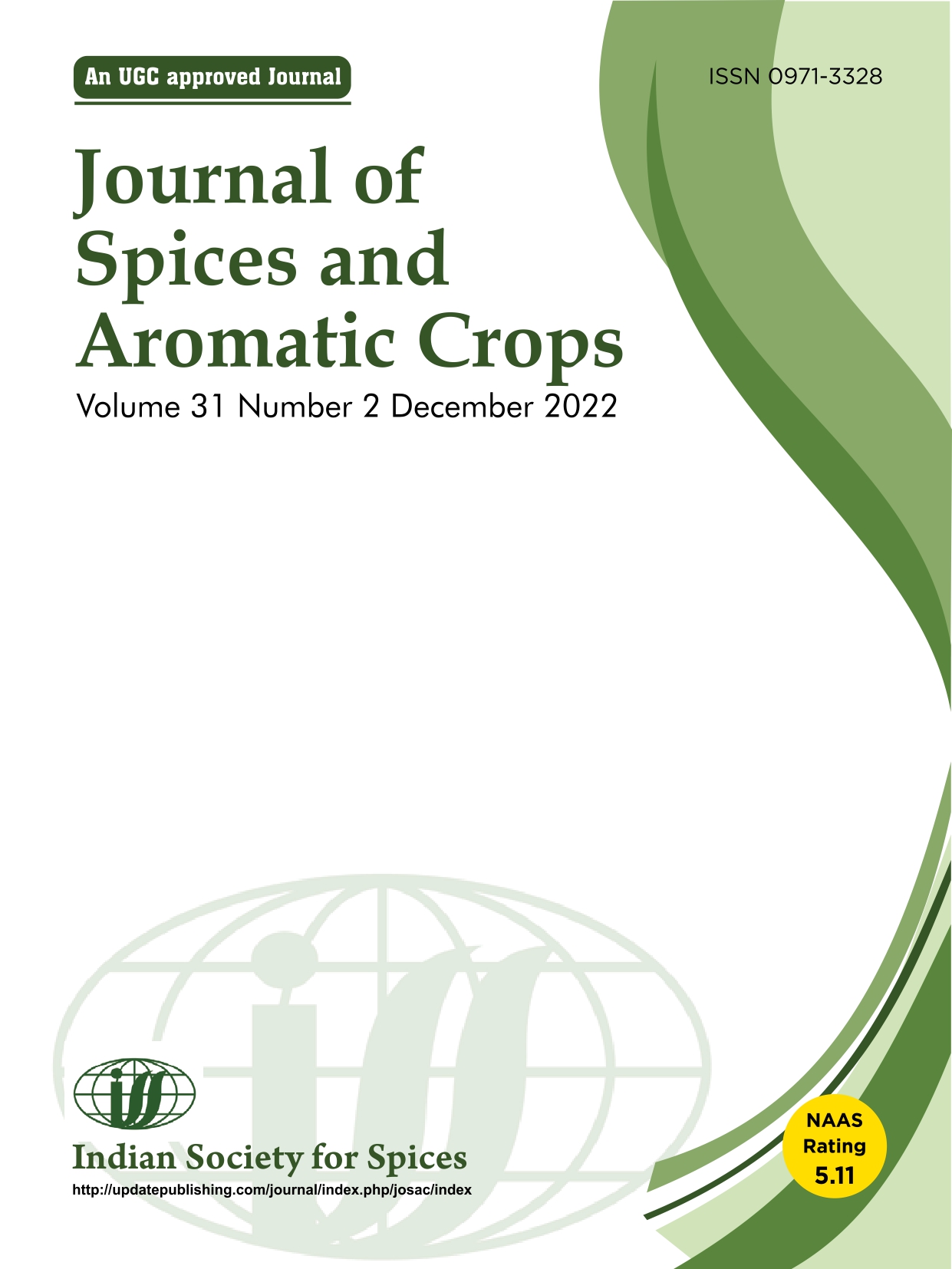Evaluation of phytochemical and nutritional composition of Boriavi ginger variety
Evaluation of Boriavi ginger
DOI:
https://doi.org/10.25081/josac.2022.v31.i2.8027Keywords:
spice, medicinal plant, nutritional composition, antioxidant activityAbstract
The “Boriavi” variety of ginger was evaluated for its phytochemical and nutritional composition. The proximate composition was found to be 86.30 ± 0.11% moisture content (% wet basis), 2.70 ± 0.06% protein content, 0.60 ± 0.01% fat content, 1.30 ± 0.07% fiber content, 1.88 ± 0.02% ash content, and 7.20 ± 0.11% carbohydrate content. The ascorbic acid content was found to be 6.55 ± 0.26 mg per 100g, antioxidant activity was found to be 86.94 ± 0.16% by DPPH method, and total phenolic content was found to be 41.45 ± 0.17 mg GAE per 100ml. The mineral composition in fresh ginger was also evaluated in which phosphorus (10955 ± 2.00 mg kg-1) was found to be the highest among all minerals.
Downloads
References
Ajav E A & Ogunlade C A 2014 Physical properties of ginger (Zingiber officinale) Global Journal of Science Frontier Research D, Agricultural and Veterinary. 14(1): 1–8.
Anonymous 2018 Horticultural Statistics at a Glance 2018 Horticulture Statistics Division, Department of Agriculture, Cooperation & Farmers’ Welfare, Ministry of Agriculture & Farmers’ Welfare, Government of India.
AOAC 2012 Official methods of analysis (19th ed.), Washington DC, USA.
Bartley J P & Jacobs A L 2000 Effects of drying on flavour compounds in Australian‐grown ginger (Zingiber officinale) J. Sci. Food Agric. 80(2): 209–215.
Evans W C 2009 Trease and evans’ pharmacognosy E-book, Elsevier Health Sciences pp289–292.
FAO 2018 http://www.fao.org/faostat/en/#search/ ginger
Hema 2017 Evaluation of Storage Methods and Value Addition of Ginger (Zingiber officinale), M.Sc Thesis, Department of Food Science and Technology. Dr YS Parmar University of Horticulture and Forestry, Solan
Joshi N Bains K & Kaur H 2019 Optimization of drying time and temperature for preparation of antioxidant rich vegetable powders from unconventional leafy greens. Chemical Science Review and Letters, 8(29): 70–78.
Maizura M, Aminah A & Wan Aida W M 2010 Total phenolic content and antioxidant activity of kesum (Polygonum minus), ginger (Zingiber officinale) and turmeric (Curcuma longa) extract, Int. Food. Res. J. 17: 45–53.
Malu S P Obochi, G O Tawo E N & Nyong B E 2009 Antibacterial activity and medicinal properties of ginger (Zingiber officinale) Glob. J. pure appl Sci. 15: 3–4.
Policegoudra R S & Aradhya S M 2007 Biochemical changes and antioxidant activity of mango ginger (Curcuma amada Roxb) rhizomes during postharvest storage at different temperatures, Postharvest Biology and Technology, 46(2): 189–194.
Purnomo H Jaya F & Widjanarko S 2010 The effects of type and time of thermal processing on ginger (Zingiber officinale Roscoe) rhizome antioxidant compounds and its quality. Int. Food. Res. J. 17: 335–347.
Ranganna S 2007 Handbook of analysis and quality control for fruit and vegetable products 2nd ed. New Delhi, India: Tata McGraw-Hill Publications.
Shirin A P & Prakash J 2010 Chemical composition and antioxidant properties of ginger root (Zingiber officinale) J. Med Plants Res. 4(24): 2674–2679.
Srinivasan K 2017 Ginger rhizomes (Zingiber officinale), A spice with multiple health beneficial potentials. Pharma Nutrition, 5(1): 18–28.
Thimmaiah S R 1999 Standard methods of biochemical analysis, Kalyani Publishers, New Delhi.
Published
How to Cite
Issue
Section
Copyright (c) 2023 Hemrajsinh Chhasatiya, Govind Tagalpallewar

This work is licensed under a Creative Commons Attribution-NonCommercial-NoDerivatives 4.0 International License.






 .
.